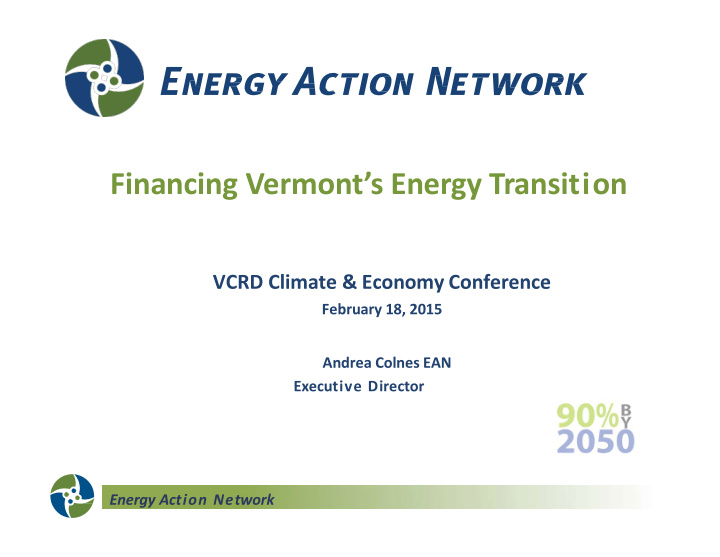



Financing Vermont’s Energy Transition VCRD Climate & Economy Conference February 18, 2015 Andrea Colnes EAN Executive Director Energy Action Network
Mission: To end Vermont’s reliance on fossil fuels and to create clean, affordable and secure electric, heating, and transportation systems for the 21st Century. Members: Businesses, organizations, individuals, government Goal: To meet 90% of Vermont’s 2050 energy needs through energy e ffici ency and rene wabl e energy. Energy Action Network
EAN Participants Energy Action Network
EAN Energy Pathways Report • Analysis of policy & technology pathways to achieve state’s CEP goal of 90% by 2050 • Ranked pathways by impact • Suggested decade milestones to reach CEP goal • 20% by 2020 • 40% by 2030 • 70% by 2040 • 90% by 2050 Energy Action Network
Strategic Context: Our Current Energy Mix 100% 2.9 11.4% total 16.9 5.9 energy use 90% 8.2 renewable 80% 70% 60% 50% Renewable 57.9 131.5 41.6 40% 32.1 Fossil/Nuclear 30% Units = TBTU Trillion BTU 20% 10% 0% Transport Thermal Electricity All Sectors Energy Action Network
Transformation S--Curve 90 by 2050: Tech Adop3on Curve & Milestones 100% 90% 80% Idealized technology 70% adopPon curve % Renewable 60% 50% 40% CEP implementaPon Where we targets based on key are today 30% driver inputs 20% 10% 0% 2000 2005 2010 2015 2020 2025 2030 2035 2040 2045 2050 2055 2060 2065 2070 Year Energy Action Network
Energy Ac*on Network
LEAP modeling courtesy of David Hill, VEIC
LEAP modeling courtesy of David Hill, VEIC
Clean Energy Finance Initiative Steering Committee Energy Ac*on Network
Annual spend -- Non--ExhausPve VT Financial Support for Clean Energy: Complex; Many Players; Mostly Grants Funding Commercial Electricity State Treasury RGGI Funds Vermont Yankee Other Paper Ratepayer Funds Intermediaries Private EVT VEDA CEDF GMP Non- - Profits Other Banks $5.46 M $6.5 M + $53.1 M $0.35 M $21 M $3 M Clean Energy & Energy E ffici ency End--u sers Rebates Financing Total: $89 M+
Vermont identifies over $33 billion in clean energy investment Selected Technologies Total Current Installed Capacity Total Poten3al Market Total Un fi lled Poten3al Cost Wind 214 MW 329 MW $312 M 1 Solar PV 87 MW 2,248 MW $6,000 M 2 Energ y Efficiency Electric 993 GWh 5,219 GWh $1,884 M 3 Thermal 218,000 MMBtu 32,000,000 MMBtu $9,699 M Bioenergy Electric Genera3on 1 88 MW 132 MW $158 M 4 Transporta3on 801 EVs 400,000 EVs $415 M for Vehicles 43 Public EVSE $779 M for EVSE 127,000 Bio Vehicles $1,194 M Total 20,000 Bio Trucks 5 500 Public EVSE Thermal Fuel Switching N/A 20,000,000 MMBtu $6,898 M 6 Electric Grid Upgrades 2 N/A N/A $7,034 M 7 TOTAL N/A N/A $33,322 M
Largest VT energy sources are gasoline for transport and fuel oil for building heat • Gasoline is over 25% of total state energy use • Fuel oil is second largest source, drives costs • Electricity is fairly clean, but dependence on natural gas is growing Key Vermont Energy Ques3ons How does VT reduce use of fuel oil for heating? • How does VT replace nuclear with clean electricity, and ensure new • electricity is also clean? How does VT replace gasoline cars with electric vehicles? •
Vermont government must build a bridge to create e ffi cient clean energy markets Vermont Initiative Efficie nt Market Supply Clean Energy Market Demand Market • Bridge the gap between supply and demand • Use resources effic iently with targete d finan cing, demand generation and market development
Clean Energy Finance Initiative Thank You! Questions: Andrea Colnes Energy Action Network acolnes@eanvt.org
Recommend
More recommend